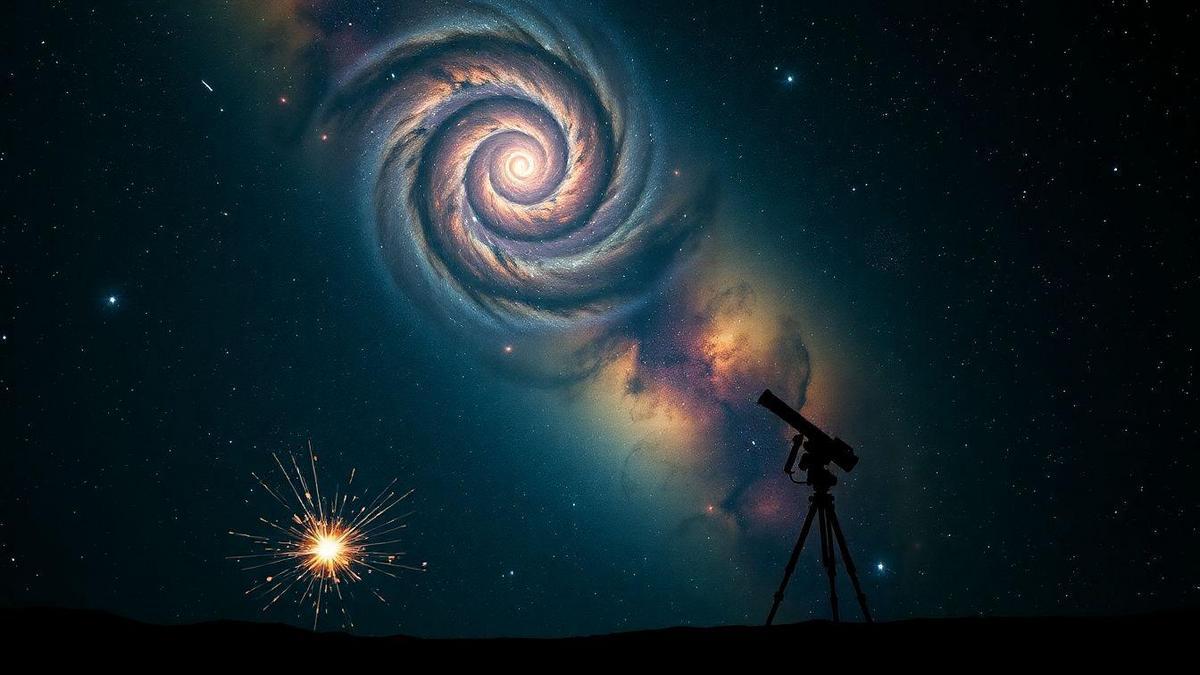
Cosmic inflation is a theory that revolutionized how scientists understand the early universe. Proposed in the 1980s by Alan Guth and other physicists, this theory suggests that shortly after the Big Bang, the universe underwent an extremely rapid exponential expansion. During this brief period, which lasted only fractions of a second, the universe expanded from a subatomic scale to astronomical dimensions. This phenomenon is fundamental for explaining the homogeneity and isotropy observed in the cosmic microwave background radiation, as well as the large-scale structure of the cosmos we observe today.
The importance of cosmic inflation in modern cosmology cannot be overstated. It provides a mechanism to understand the uniformity of the universe and solves classic problems in Big Bang cosmology, such as the flatness problem and the horizon problem. Additionally, cosmic inflation offers a bridge between quantum physics and cosmology, allowing scientists to explore the quantum fluctuations that gave rise to the structures we see today. In summary, cosmic inflation is a key piece in the puzzle of the origin and evolution of the universe.
How do the principles of cosmic inflation work?
The principles of cosmic inflation are rooted in fundamental concepts of physics, combining elements of Einstein’s general relativity with quantum mechanics. The central idea is that during inflation, the universe was dominated by a form of energy called “vacuum energy,” which caused the rapid expansion. This energy is often associated with a scalar field that, when interacting with spacetime, drives this accelerated expansion. Thus, cosmic inflation is not just a growth phase but a process that alters the structure of spacetime itself.
One of the most intriguing aspects of cosmic inflation is how it generates quantum fluctuations that become the seeds of the structures we see in the current universe. During inflation, quantum fluctuations are “stretched” to larger scales, becoming perturbations that eventually evolve into galaxies and galaxy clusters. These small deviations in the density of the primordial universe are crucial for the formation of large-scale structures. Therefore, cosmic inflation not only explains the universe’s expansion but also provides a mechanism for the variation we observe in the matter distribution.
Another key principle of cosmic inflation is its ability to solve classical cosmological problems. The flatness problem, for example, refers to the observation that the universe appears to be extremely close to flat geometry. Cosmic inflation provides a natural explanation for this since the rapid expansion “flattens” any initial curvature. Similarly, the horizon problem, which questions how different regions of the universe can have similar temperatures despite being separated by vast distances, is resolved by the idea that these regions were previously in contact before cosmic inflation occurred.
Finally, cosmic inflation also opens doors to new theories and cosmological models. Ongoing research in this field is leading to new ideas about the nature of the universe, such as the possibility of multiple universes or “multiverses.” These concepts not only expand our understanding of the cosmos but also challenge the boundaries of what we know about reality. Thus, the principles of cosmic inflation are fundamental to cosmology and physics as a whole.

Advantages of understanding cosmic inflation: what do we know 40 years later?
Understanding cosmic inflation brings numerous advantages to cosmology and physics in general. First, it provides a robust explanation for the uniformity observed in the cosmic microwave background radiation. This radiation, a relic of the Big Bang, has a nearly constant temperature in all directions of the sky, a phenomenon that the theory of cosmic inflation explains satisfactorily. The ability to connect this uniformity to a specific physical event, such as cosmic inflation, is one of the great achievements of modern cosmology.
Moreover, cosmic inflation helps solve problems that were once considered thorny in cosmology. The flatness and horizon problems, as mentioned earlier, are issues that challenge the logic of the Big Bang model. Cosmic inflation offers simple and elegant solutions to these problems, allowing cosmologists to develop more coherent and predictive models of the universe’s evolution. This strengthens the Big Bang theory and provides a solid foundation for future investigations.
Another significant benefit of cosmic inflation is its ability to connect particle physics with cosmology. The theory suggests that the quantum fluctuations that occurred during inflation are responsible for forming the structures we observe today. This connection between particle physics and cosmology is crucial, as it allows physicists to test quantum theories on astronomical scales, something difficult to achieve in laboratory experiments.
Finally, cosmic inflation paves the way for new theories and cosmological models that could revolutionize our understanding of the universe. After 40 years of research, scientists have begun to explore concepts such as eternal inflation and the possibility of multiple universes. These ideas not only challenge traditional notions of a single universe but also expand the scope of cosmology to include phenomena that were once considered beyond the reach of science.
How does cosmic inflation influence our understanding of the primordial universe?
Cosmic inflation plays a fundamental role in how we understand the primordial universe. By addressing the uniformity of the cosmic microwave background radiation, cosmic inflation provides a convincing explanation for the observed homogeneity, which is one of the pillars of modern cosmology. This radiation, which permeates the cosmos, is a witness to the universe’s initial state, and through cosmic inflation, we can understand how that uniform state was formed.
Additionally, the theory of cosmic inflation is crucial for explaining the origin of the quantum fluctuations that became the seeds of the universe’s structure. These fluctuations, which arise at subatomic scales, are stretched to cosmological dimensions during cosmic inflation, allowing them to become the galaxies and clusters we observe today. This connection between quantum physics and cosmology is one of the most fascinating aspects of cosmic inflation, as it opens new avenues for scientific research.
Cosmic inflation also offers a robust model for understanding the expansion of the universe. Understanding how the universe transitioned from a superdense, hot state to the vast cosmos we know today is a central question in cosmology. Cosmic inflation provides a theoretical framework that explains not only the expansion but also its characteristics, allowing for predictions that can be tested through observations.
Finally, cosmic inflation is a bridge between particle physics and modern cosmology. This interconnection is vital for the advancement of physics, as it enables scientists to test theories on scales that are impossible to reach in laboratory experiments. By solving classical problems of the Big Bang model and opening the way for new theories, cosmic inflation remains a vibrant and promising area of research.

Did you enjoy learning more about cosmic inflation: what we know 40 years later?
Cosmic inflation is a fascinating topic that continues to capture the imagination of scientists and astronomy enthusiasts. Understanding this theory allows us to explore the universe’s origins and the mechanisms that shaped the reality we know today. What we have learned over the past 40 years is not only a testament to human curiosity but also an invitation to continue exploring the mysteries of the cosmos.
As new discoveries are made and new technologies are developed, cosmic inflation promises to keep revealing secrets about the universe’s nature. With each advance, we come closer to answers to fundamental questions about the origin and evolution of the cosmos. The future of cosmology is bright, and cosmic inflation is at the center of this exciting journey.
Cosmic inflation is one of the most intriguing and impactful concepts in modern cosmology. By understanding this theory, we can not only explain the structure and uniformity of the universe but also connect different branches of physics in a way that once seemed impossible. Discoveries made over the past 40 years reveal a universe far more complex and fascinating than we ever imagined.
If you found this topic interesting, keep exploring the wonders of cosmology and physics. The journey of knowledge is endless, and there is always more to discover about the cosmos and our place within it.
Frequently asked questions
What is cosmic inflation?
Cosmic inflation is a theory proposing that, in the universe’s first moments, it expanded rapidly. This helped shape everything we see today.
Why is cosmic inflation important?
Cosmic inflation explains how the universe became so homogeneous. Without it, we would have a very different universe.
What do we know 40 years later about cosmic inflation?
Forty years later, the theory of cosmic inflation remains a hot topic. Many observational findings support it, but there are still mysteries to solve.
What are some evidences of cosmic inflation?
Observations of background radiation and galaxy distributions provide strong evidence. These findings show that cosmic inflation existed and shaped the universe.
What are the current challenges in inflation research?
Researchers still struggle to fully understand cosmic inflation. Questions about its nature and its relationship with dark energy remain unanswered.

